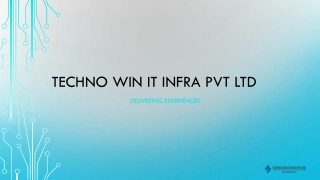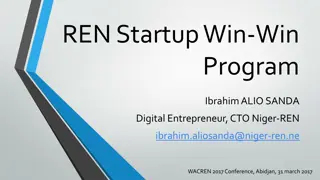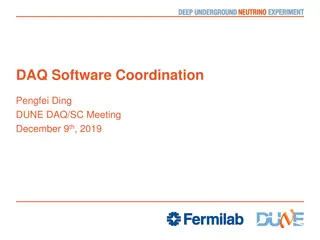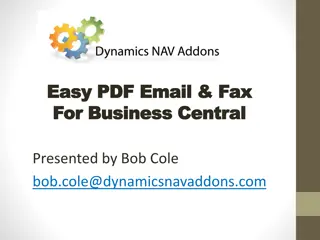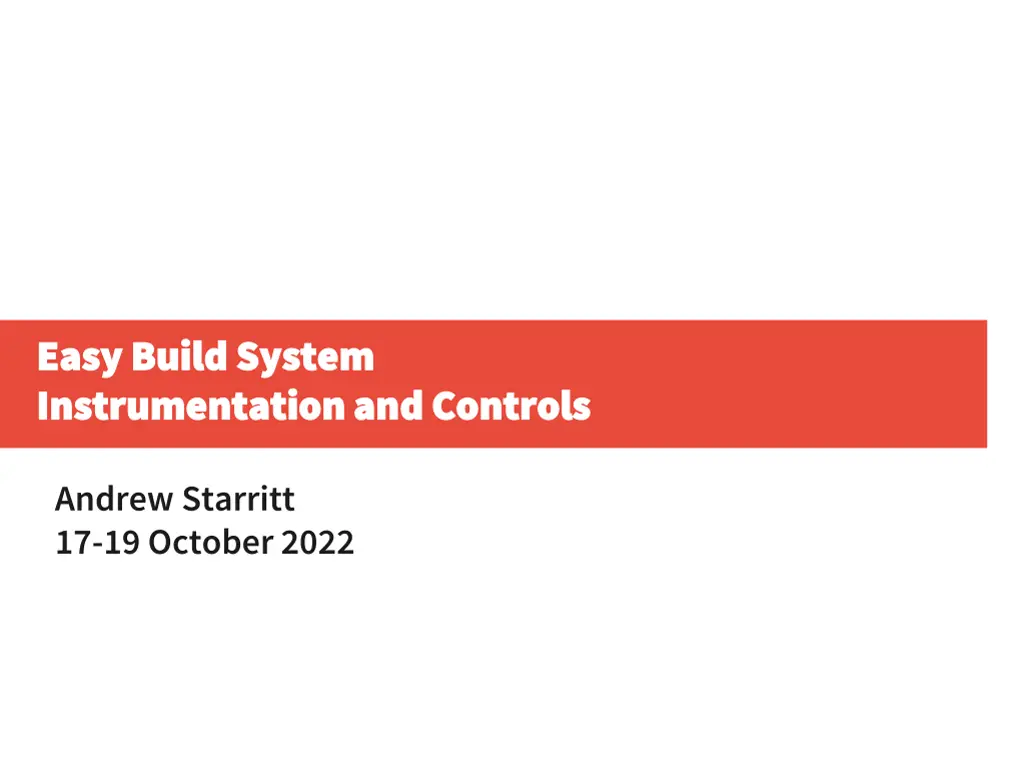
Easy Build System Overview
"Discover the Easy Build System (EBS), a collection of scripts that facilitate the construction and deployment of EPICS IOCs and various applications, ensuring consistency across platforms. Learn about its main features, workflow, and benefits."
Download Presentation

Please find below an Image/Link to download the presentation.
The content on the website is provided AS IS for your information and personal use only. It may not be sold, licensed, or shared on other websites without obtaining consent from the author. If you encounter any issues during the download, it is possible that the publisher has removed the file from their server.
You are allowed to download the files provided on this website for personal or commercial use, subject to the condition that they are used lawfully. All files are the property of their respective owners.
The content on the website is provided AS IS for your information and personal use only. It may not be sold, licensed, or shared on other websites without obtaining consent from the author.
E N D
Presentation Transcript
Easy Build System Easy Build System Instrumentation and Controls Instrumentation and Controls Andrew Starritt 17-19 October 2022
Introduction Introduction Overview What is it, main features. Workflow Overview The recipe files. Deploying built IOCs Pros and Cons
What is the Easy Build System? What is the Easy Build System? The Easy Build System (EBS): In a nutshell: it is a collection of scripts that allow EPICS IOCs and other applications such as bundles*, gateways, archivers, extensions (edm, medm, msi, etc.), GUIs (EPICS Qt, Delphi) etc. to be constructed (compiled, linked, generated) and deployed to the target host in a consistent manor across multiple platform types. * a bundle is a pre-built set of EPICS modules.
Main Features 1 Main Features 1 The main features of the EBS are: It is recipe driven build system used to consistently and repeatably construct EPICS IOCs and other applications. The recipe files, all the associated source code, configuration files, database files, .ui, .adl files etc. are extracted from the source code control system (perforce). If it s notin perforce, it s not in the build. The build is run on dedicated and independent (i.e. non- operational*, non development) build host(s). * * SXR used to use an operational host as build box we could only build on maintenance days (this was before virtual machines widely available).
Main Features 2 Main Features 2 It supports a number of independent build streams, typically one per operational area: machine, archives, gateways, beamlines. Each build stream can support many platform types, including CentOS 5, 6, 7, 8, CentOS Stream, debian, ubuntu, redpitya, libera, dimtel; and we used to support CentOS 4, win32 and cygwin. For a standard IOC, the build system auto-generates a deploy script that will deploy the required files from the build repository to the target host machine. Used to all IOCs, gateways and archivers OPIs used a be-spoke deploy script.
Main Features 3 Main Features 3 The build is started by a parameter-less command: bs_start_build The build may be started manually or initated by a cronjob (as we do nightly) or similar (Jenkins ??) The build process also generates many artifacts/log files and a Change Control Board (CCB) report detailing which issues affected which IOCs. It also generates a basic build status web page. I look at these first thing each morning (after coffee ;-)
Web Status page Web Status page
CCB Report (part 1) CCB Report (part 1)
CCB Report (part 2) CCB Report (part 2)
Why did we create the EBS? Why did we create the EBS? A build system was deemed necessary as we have many IOCs etc. running on multiple platforms and platform types: 225+ IOCs, OPIs, Archives, Gateways, File Servers very labor intensive to build on each individually, and on own target hosts. Target hosts not always suitable to use as build machine because either in use operationally and/or have no build capability.
EBS Workflow Overview EBS Workflow Overview
Overall Structure Overall Structure The EBS allows for a number of independent build streams We currently have four. Each build stream can build any number of platform types. The machine currently has 8 all flavours of Linux. The archivers and gateways each have 1. The bundle has 2. Each platform type is built on its own dedicated (VM) host. Each platform can build many IOCs, OPIs etc. etc.
The Contracts The Contracts The build (top) directory (out of perforce): Must contain at least a build_instruction Must contain at least a build_instruction recipe file recipe file. . Either in the top directory or called up by the recipe file: Must contain script (or program) build.sh If build.sh exists, it is executed; otherwise; exists, it is executed; otherwise; If a Makefile Makefile exists, make is invoked ; otherwise exists, make is invoked ; otherwise This item fails to build. Must contain script (or program) build.sh or or Makefile Makefile If build.sh If a This item fails to build. In the top directory, or specified in the recipe or built: Should optionally contain a deploy.bash If it does not exist, the EBS will create a symbolic link to the auto generated deploy_ioc.bash deploy_ioc.bash script. script. Should optionally contain a deploy.bash script script If it does not exist, the EBS will create a symbolic link to the auto generated
Reciple Reciple file (part 1) file (part 1) The build (top) directory (out of perforce): Must contain at least a build_instruction recipe file. It typically holds other files, such as the files for the IOC shell (example later) The recipe file consists of a list of items which are copied to the top directory/folder These items may be files or directories typically the latter. A specific release version may be defined otherwise the head revision is used Specified using perforce labels similar to git tags The item can be directed to a sub folder The item can be renamed.
Recipe file (part 2) Recipe file (part 2) example example
Recipe file (part 3) Recipe file (part 3)
Recipe file (part 4) Recipe file (part 4)
Top directory Top directory - - typical typical
Building Building This is guided by the Makefile or build.sh file. Typically, we use a standard EPICS Makefile. If used, the build.sh can be any script or executable that gets the job done. When a build is ready for deployment, it is copied from the from the build host to a shared and public NFS mount point. A build does not necessarily have to be 100% successful in order to be made available.
Copying to shared drive (example) Copying to shared drive (example)
Deploying an IOC, OPI, . 1 Deploying an IOC, OPI, . 1 Each built IOC/OPI/gateway etc. should contain a deploy.bash script. This scripts deploys the run time artifacts from the build repository (on shared drive) to the target machine. For IOCs the deploy script is automatically generated. For IOCs we deploy: binaries, libraries, EPICS database and dbd files. The iocBoot directory inc. the st.cmd file
Deploying an IOC, OPI, . 2 Deploying an IOC, OPI, . 2 We do not deploy source code and intermediate object files. The deploy.bash script is run on the target host. Can be run remotely and in parallel using cssh I also have some be-spoke scripts to help me deploy certain host groups, e.g. I can deploy all the gateways in one go. Not every host need be updated when a new build is available. The build is copied to a build specific location, e.g.: /asp/builds/accelerator_build0288 where the 0288 is an automatically allocated build number
De2loying an IOC, OPI, . 3 De2loying an IOC, OPI, . 3 Multiple builds can exist on the same host The active build is selected via a symbolic link /asp/ics -> /asp/builds/accelerator_build0288 This allows us to easily revert to a previous build in the case of a "stuff" up. The set_build script selects and logs the current build The show_build script displays the currently selected build.
Deploying a build to an IOC Deploying a build to an IOC - - example example
Select/Show the active build Select/Show the active build
Implementation Implementation The EBS is implemented as set of bash scripts (running on Linux) The are approx. 7300 lines of bash. Contains a lot of fossil scripts, obsolete platform scripts, especially for Windows. We did consider using Python, however bash is ubiquitous and available on all distributions that we use. The EBS is very much tied in with the perforce source code management. We are looking into migration to a git-based system.
Pros and Cons Pros and Cons Pros A lot of automation for building and deployment. Everything in source code controlled. All the items are located and built in the IOC top directory, specifically, all the application database files are in the local <top>db/ directory Cons There is a relatively large learning curve. A large over head if only managing a few IOCs. Relatively large turn around time for a single IOC.
Credits Credits Design philosophy: Steven Banks Implementation: Mark Bennett, Glenn Jackson




